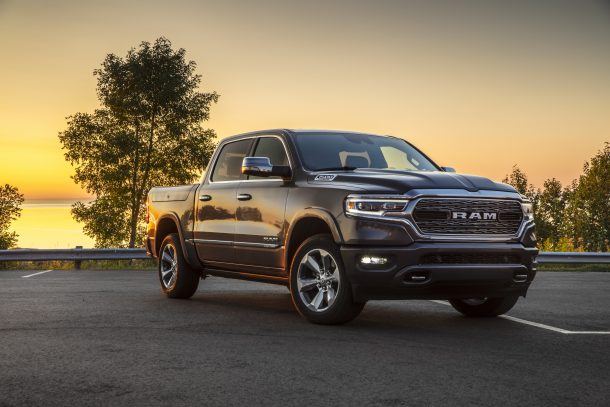Detroit Truck Wars: Ram Gains Ground on a Sinking Ford As GM Rises

Never have pickup trucks mattered more to an automaker, especially domestic automakers. As sedans and coupes fall off, trucks make up an ever greater percentage of a company’s sales, and the greater (and quickly rising) average selling prices of these hulking family vehicles means there’s a pot of gold waiting for those who succeed.
While the full-size pickup front-runner hasn’t changed since the early 1980s, Ford’s F-Series faces growing competition from two traditional foes. Both Fiat Chrysler and General Motors have newer pickups on the market, and it’s eating into the popularity of the untouchable F-Series.
Both Ram, Chevrolet, and GMC debuted new full-size and heavy-duty pickups in the past year and change, while Ford finds itself awaiting an imminent redesigned Super Duty and a next-generation F-150 due next year.
Ford’s recent move to quarterly sales reporting was aimed at reducing the significance of monthly year-over-year changes to vehicle demand — a practice easily upset by the timing of fleet orders. But the move can’t change the fact that F-Series demand is down this year, and not just in the past quarter. In Q3 2019, F-Series sales sank 6 percent, while Ram truck sales rose 14 percent. Chevrolet’s Silverado 1500 is up 18 percent, while the new Silverado Heavy Duty is also up 7.1 percent. For GMC, Sierra and Sierra HD sales rose 38.2 percent and 9.7 percent, respectively.
Some of these gains (and in the case of Ford, losses) can be attributed to the timing of recent or impending model introductions and the sell-down of old stock, though the latter element doesn’t apply to the Ram 1500, which soldiers on in two forms: new and old (1500 and 1500 Classic).
Since the start of the year, F-Series sales have declined 2.4 percent — a figure Ford can’t escape from. As this year’s quarters progressed, the year-over-year sales gap grew from a 0.2 percent gain in Q1 to a 1.3 percent loss in Q2, then Q3’s 6 percent drop. It’s not surprising for an older model to suffer from advancing age and increased competition from newer segment rivals, but this is the F-Series. Between Q1 and Q3, the quarterly sales gap between F-Series and Ram shrank from 94,585 units to 52,541.
Thankfully for Ford, the F-Series’s cooling-off period coincides with the introduction of the midsized Ranger, a truck that found 26,211 buyers in the last quarter. The added volume from Ranger, plus increased demand for the Transit and Transit Connect vans, pushed Ford’s all-important truck division to an 8.8 percent quarterly sales gain.
Because of this, Ford’s not hurting from the loss of its Taurus, Focus, and Fiesta. (The impact of that last model’s cancellation, however, hasn’t been felt — the Fiesta continued its winning streak last quarter, even in death. It’s up 44.7 percent for the year.) Not hurting, but even more dependent on the success of its trucks than ever.
At the end of the last quarter, F-Series accounted for 38.8 percent of Ford sales, up from 38 percent at the end of Q1. At the end of Q1 2018, F-Series accounted for 37.1 percent of Ford-branded vehicles.
It’s not like Ford was resting on its laurels while its rivals unveiled new trucks. The automaker introduced a class-exclusive light-duty diesel last year, moving the mill downmarket to the XLT trim for 2019. Ram and GM were soon to follow with their own 3.0-liter mills. Behind the scenes, Ford engineers are working on two market firsts: a hybrid pickup, expected when the next-gen F-150 bows, and a future F-150 EV. (GM has pledged to rival the latter model with an EV of its own.)
Shortly, Ford will be able to tempt buyers with its 2020 Super Duty line — a stable of trucks boasting a new 7.3-liter gas V8 and a revamped Power Stroke diesel that tops Ram’s equally refreshed Cummins unit in terms of torque and towing. Next year will be all about the 14th-generation F-150, due out as a 2021 model.
Let it never be said that competition isn’t good.
[Images: Ford, Fiat Chrysler Automobiles, General Motors]

More by Steph Willems
Latest Car Reviews
Read moreLatest Product Reviews
Read moreRecent Comments
- Jalop1991 is this anything like a cheap high end German car?
- HotRod Not me personally, but yes - lower prices will dramatically increase the EV's appeal.
- Slavuta "the price isn’t terrible by current EV standards, starting at $47,200"Not terrible for a new Toyota model. But for a Vietnamese no-name, this is terrible.
- Slavuta This is catch22 for me. I would take RAV4 for the powertrain alone. And I wouldn't take it for the same thing. Engines have history of issues and transmission shifts like glass. So, the advantage over hard-working 1.5 is lost.My answer is simple - CX5. This is Japan built, excellent car which has only one shortage - the trunk space.
- Slavuta "Toyota engineers have told us that they intentionally build their powertrains with longevity in mind"Engine is exactly the area where Toyota 4cyl engines had big issues even recently. There was no longevity of any kind. They didn't break, they just consumed so much oil that it was like fueling gasoline and feeding oil every time




































Comments
Join the conversation
Glad to see that the Ridgeline is almost at the bottom of the heap. What a stupid vehicle that has always been.
Glad to see that the Ridgeline is almost at the bottom of the heap. What a stupid vehicle that has always been.